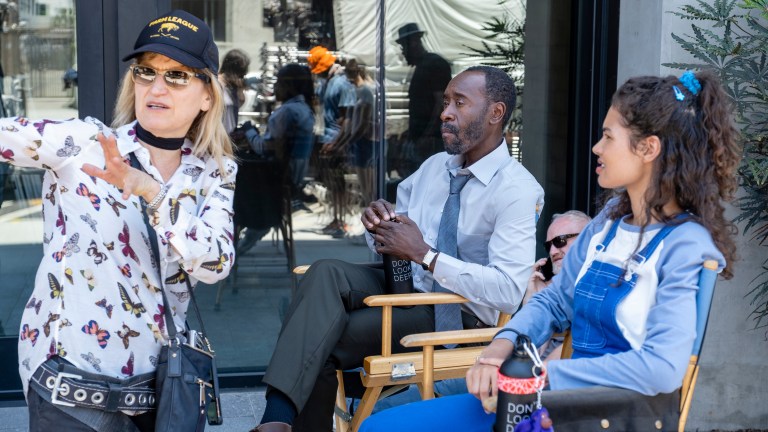Don’t Look Deeper: Catherine Hardwicke on Self-Discovery via the Turing Test
The director of Quibi’s Don’t Look Deeper on finding the spark of truth in a sci-fi coming-of-age tale.

For a series called Don’t Look Deeper, Quibi’s sci-fi offering challenges its own title in the opening scene, in which teenager Aisha (Madeline’s Madeline’s Helena Howard) digs into her arm to find the truth beneath her skin. It’s a grisly sequence that mirrors a scene in Alex Garland’s 2014 film Ex Machina, except that Aisha is a biracial young woman, doubting her own personhood, not a white man; and her story takes place in 7-to-10-minute chunks totaling the length of a feature film. This short-form serialized storytelling is a hallmark of the new streaming service, originally intended for commuters and other on-the-go viewers, which had the awkward timing of debuting in the middle of a pandemic.
However, that change of plans hasn’t discouraged director Catherine Hardwicke; she calls it “beautiful” that Don’t Look Deeper can be watched in bits and pieces or binged all at once. The Thirteen and Twilight director has brought her considerable experience helming formative tales of teenage girls’ self-discovery to this unconventional (yet retro) serialized storytelling format, and to a heroine who is othered twice over, yet who Hardwicke hopes will inspire viewers to greater recognition of our shared humanity.
Den of Geek spoke with Hardwicke in June about envisioning the future in little touches instead of broad strokes, watching Evan Rachel Wood in Westworld, and how Don’t Look Deeper takes on an unexpected dimension in light of the current #BlackLivesMatter protests.
DEN OF GEEK: What was it like directing for 7-to-10-minute episodes, as opposed to a feature film?
CATHERINE HARDWICKE: [It] was challenging, but I love this format, because I do think it’s how we live now. I often have just five minutes [to do something] and I can’t spend the whole day, but I want something to feed my brain. It was fun for me because I suddenly broke up [my] storytelling—became more nonlinear and more innovative [about] how to start an opening of an episode or how to end it; where to find that heightened, dramatic moment, that pivotal moment that would make you hopefully want to come back and say, “How is this going to end? How is that gonna be resolved?” It really sharpened my storytelling skills in a new way. It was kinda mind-blowing for me.
Of course, and each episode of Don’t Look Deeper has an opening that’s just a few seconds, with a very thriller-y tone. Did you collaborate with the writers to decide what those moments would be?
The episodes were very far along when I came on the project. The writing was very detailed; however, the writers didn’t know at that time that [the episodes] had to be 10 minutes; they didn’t know how many there would have to be. So, we worked together on developing it. We did have to shift it around and find new endpoints and new out-points. That was kind of exciting. We had a big board on the wall—all of the episodes, all of the scenes, how could we make this work better.
Did you have a favorite or most challenging episode or sequence to shoot?
I really loved any time that we were trying to get inside [Aisha’s] memories, her brain, how to make her feel like she was in that altered state—not wanting to spoil—in her “other” state. I loved every challenge [such as] what could the other robots look like—the school robots that were supposed to be robots, not cross the uncanny valley, so that people felt comfortable around them—how do you create those characters.
[Episode 6 features a quasi-chase sequence in which a self-driving car suddenly malfunctions, and Don Cheadle’s character Martin must fumble to drive.]
It was interesting because it was kind of a chase sequence. Because it’s fifteen minutes in the future, [you consider] what kind of car, how could you have a modified device on your car that could be auto-driving, and then how could that malfunction. Every action sequence and every stunt person in the world, we’re always trying to think of new car chases that haven’t been seen; so the future gave us the perfect opportunity for that, adding a new element.
Quibi was originally intended to be used by commuters and on-the-go audiences, by people who have their days broken into little chunks of time for consuming entertainment—and then the worst possible timing happened with the pandemic. How does it feel to release a Quibi series knowing that it likely won’t be viewed the way it was originally intended?
I always thought it was fantastic that it would be parsed out over multiple days so you could have that fun [experience] all the way back to the early 1900s when they had serial stories, every Saturday you’d go back and watch The Perils of Pauline—obviously that sounded fun. But the idea that you can just sit down and watch it all together, I love that too. We knew that would always be available and probably a huge percentage of people would find it just like we all find, whatever, Money Hunters and we watch it all. So I think it’s beautiful that it can be watched either way.
You’ve directed these groundbreaking stories about young women coming to grips with their bodies and their power, including Thirteen and Twilight. What was it important to you to bring from those experiences to Don’t Look Deeper?
One thing I thought was pretty interesting [is that] Thirteen is a coming-of-age story where a person is trying to figure out, “Who am I as a person? Am I a bad girl? Am I sexy? Do I do drugs? Do I love my mom?” and all those questions about identity. [It’s] the same thing in this one, like on steroids—searching for identity. When you find out who you are in this case, it’s so extreme, this journey of self-discovery—what does it mean with no road map in front of you. I wanted it to feel as grounded [as possible], and with Helena I felt like she really goes for her emotional truth every time and in an original way and kinda unpredictable, sometimes the way she delivers her lines and how she attacked the scene. So I felt like that had that spark of truth and discovery, that I always try to get.
Your past projects have seen you working alongside young women in breakout roles, like Evan Rachel Wood and Kristen Stewart, not unlike Helena Howard’s breakout role in Madeline’s Madeline. How was working with Helena similar or different?
All three are just very instinctual; they just have to feel it or they can’t do the scene, it doesn’t feel real if the words don’t feel right, they have to fully inhabit their characters. That was a very strong continuity; with Helena, she really had to get deep into it, and feel it and live it and breathe it, very similar to the others.
It’s kinda funny, Evan now plays an AI, obviously, on Westworld. My husband was working on that at the same time as I was working on this, and that piece is set in the future but they had a ton of money to spend and we didn’t and I was like “grr!” [laughs] That was my challenge: how do you create that near-future without a Westworld budget. But it was really exciting because this whole show’s about technology, our love/hate affair with it: how we’re frustrated with it but we love it and depend on it and we embrace it and we’re excited by it. Since CGI has come a lot further, faster, over the last few years, you can just come up with a cool little idea—let me make that backpack glow, or let me add a solar balloon to the top of the school, or let me make the car glow like it has colored panels. So I was always trying to create little fun things like that that just gave you a hint that you were in the future, and then we could add them affordably in CGI.
Those little touches can often go a longer way than the bigger effects. Speaking of, I was struck by various recurring motifs or devices, including Aisha’s “crazy eyes” (when something goes wrong with her body) and the repetition of Aisha having to say “I accept” with regard to issues of consent and bodily autonomy. How intentionally did you highlight these and other motifs?
That’s so fun that you touched on that kind of stuff, because even the boy at the party [that Aisha hooks up with in episode 1 says,] “Are you sure this is OK? Is this OK? Are you alright with this?” It’s embedded in the culture, to ask for [consent]; but even when you ask for it, like when the male robot [asks to touch Aisha’s arm to give her information], it doesn’t feel very comfortable doing it: “I guess so, go ahead and touch me.” I think that scene was repeated but altered all through the movie, with humans, with robots, with happily consenting and unhappily consenting. It was repeated, but it was changed.
“Don’t look deeper” has so many potential meanings. Did it have a particular meaning for you while working on this project?
Part of it could be a cultural thing right now. I always think when I hear those words, “Don’t go deeper into the meaning behind whatever—systemic racism—just stay on the surface.” I feel like intellectually we do need to fight that phrase, “don’t look deeper”—yes, look deeper; yes, think more deeply; yes, care more. Dig into the details and the truth. For me, it’s the opposite of that—it’s a call for looking deeper.
You got your start as a production designer on sets run by Lisa Cholodenko, Cameron Crowe, Rachel Talalay, David O. Russell, and Richard Linklater, among others. Who are the female crew members from Don’t Look Deeper that you can shout out?
We really obviously tried to be as inclusive in the crew as we possibly could—with women, with people of color—and our crew turned out to be pretty amazing. Our DP is from Mexico, his whole crew were Latino; our AD is African-American; our second AD, a woman, [is] LGBT. Every time we tried [to ask,] “How can we seek people out in LA?” and that was a big goal, and hopefully we did pretty well. We got the ReFrame Stamp; it’s an initiative started by Sundance Institute and Women in Film, and the idea was—like how you can have “certified organic” stamped on your food, or LEED [certification] for an environmentally-sound building—you could have a stamp on your film that you did satisfy—not 50/50, but it’s getting toward 50/50 quotient of having women in key positions on your film.
We got that stamp: myself, editor Josie Azzam, composer Nora Kroll-Rosenbaum. The composer is an area that’s very low [female] representation on feature films, and that was amazing. That was partly due to Sundance; they have the [Film Music and Sound Design] Lab, where they really encourage and nurture up-and-coming female composers. That’s where I met Nora, and she just killed it; I love the score, it’s very imaginative. We had a female stunt coordinator, too! Her name is, believe it or not, Heidi Moneymaker, and she is a badass. We ended up with a nice gang, a nice group—a coven.
Love it! All film sets should have a coven.
Yes.
Don’t Look Deeper premieres July 27 on Quibi, with the season finale airing August 11.
